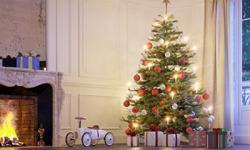Don't Let Your Holiday Take a Tragic Turn Because of Your Christmas Tree
Christmas trees add lots of joy and beauty to our households every holiday season. But let’s face it – they also add a bit of risk. By just heeding a few common sense Christmas tree safety tips, you can help ensure that the most wonderful time of the year doesn’t turn into the most tragic.
Christmas Tree Safety is Worth Taking Seriously
According to the National Fire Protection Association (NFPA), on average there are at least 250 home fires each year that are started with Christmas trees. These fires result in 14 deaths per year, and nearly $14 million in property damage.
And when they occur, house fires that start with a Christmas tree are terrifyingly ferocious. The NFPA reports that on average, 1 out of every 18 Christmas tree fires results in a death, while only 1 in 134 house fires from other causes results in death.
What Makes Christmas Tree Fires so Dangerous?
Christmas tree fires are particularly dangerous because dried-out conifer trees – the kind of tree most commonly used for Christmas trees – are incredibly flammable.
According to tests performed by the U.S. Fire Administration, a dry Scotch pine Christmas tree can be fully engulfed in flame within just 3 seconds of ignition. At the 5-second mark, flames can be licking at the ceiling. Within just 40 seconds of ignition, the entire room can be aflame, with toxic smoke fumes spreading throughout the house and the fire expanding to adjacent rooms.
Very frightening!
How to Minimize Your Risk
Don’t let the fear of a disaster dampen your enjoyment of your Christmas tree. By adhering to these few common-sense tips, you can virtually eliminate potential Christmas tree dangers:
- Don’t start out with a dry tree. Make certain that any tree you’re considering buying has not already begun to dry out. There should be no more than a few brown needles in the interior of the tree, and when the tree is shaken or touched, very few green needles should fall off.
- Before placing your tree in the stand, cut about 1/2 to 1 inch from the base off the trunk. This will help the tree to take up water.
- Make sure your tree has plenty of water available. A large Christmas tree can consume up to 2 gallons of water per day. So check the water reservoir frequently – at least once per day.
- Keep any sources of flame at least 3 feet away from the tree. (Obviously, the old-fashioned practice of festooning the tree with lit candles is not a wise move!)
- You can slow the rate at which the tree dries out by positioning it as far from heat sources as possible. Things like heat vents, lights, radiators, and even TV’s can accelerate the rate at which your tree will dry out. You can also help to keep the tree cool by using miniature or LED decorative tree lights instead of incandescent bulbs.
- Always use Christmas tree lights that are appropriately labeled, and never leave them on overnight or when you’re not home.
- Once the tree begins to drop its needles, it’s time for it to go. If your tree begins to drop its needles before the holidays are over, then you can get a replacement tree if you wish. But do not tempt fate by keeping a tree that has dried out enough to start shedding needles.
You should also be aware that a number of house fires are started each year with artificial trees. Many of the safety rules listed above - such as keeping the tree away from a source of flame - also apply to artificial trees. And when you’re shopping for an artificial tree, be sure to only consider trees that are labeled and certified by the manufacturer as fire-retardant.
By being aware of the risks and taking steps to minimize them, you can enjoy the holiday season without nagging concerns about the safety of your Christmas tree.











